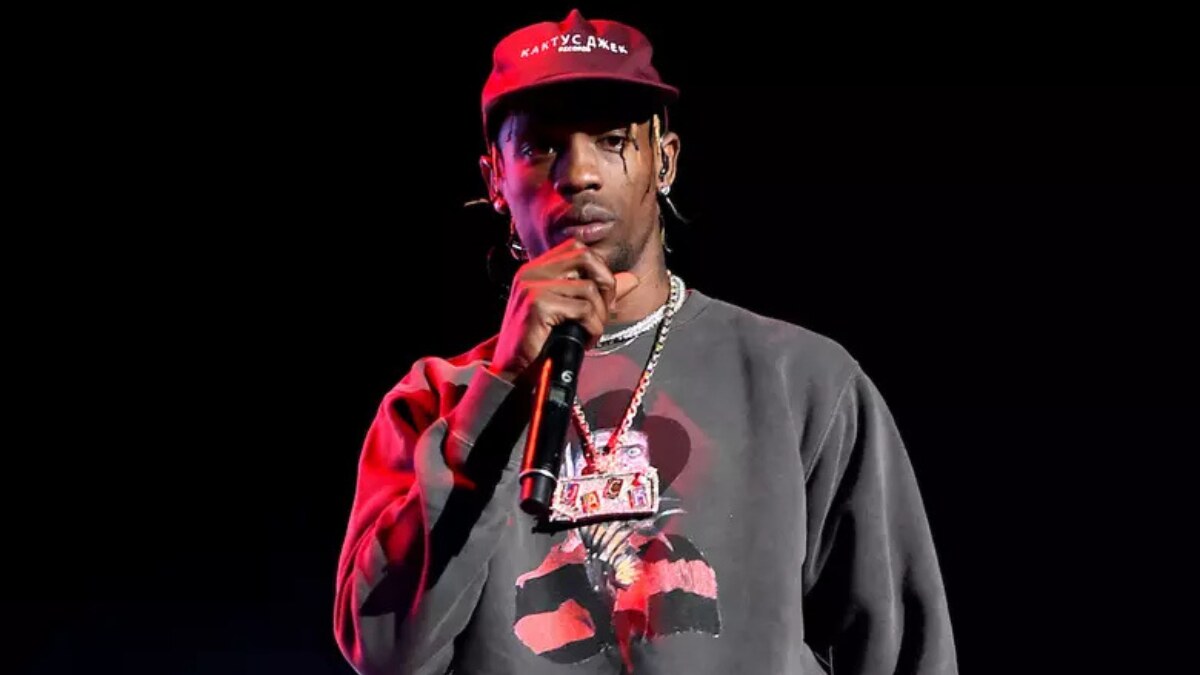The bass hit like thunder, but the crowd was already roaring louder. Thousands surged forward as Travis Scott levitated — not literally, but emotionally — above a stage designed like a portal to another dimension. Smoke cannons erupted. Flames pulsed in time with “Stargazing.” Somewhere near the barricade, a fan wept while mouthing every word, overwhelmed not by the spectacle, but by the sense that this wasn’t just a show — it was a shared fever dream.
That was Astroworld Festival at its peak: chaotic, hypnotic, and charged with the kind of energy only Travis Scott could conjure. Born Jacques Webster II, raised in the Houston suburb of Alief, Scott’s rise to fame wasn’t just a linear ascent — it was a collision of sound, style, and subculture. From the city that birthed chopped and screwed to the world stage, he didn’t just ride the wave of the Houston rap scene — he warped it into something unrecognizable and unforgettable.
This is the story of that transformation — of how Travis Scott built not just a career, but a universe.
“I’m just here to open doors for the next generation.”
— Travis Scott
H-Town Frequencies – The Sonic DNA of Travis Scott’s Origins
Screwed Up Roots and Space-Age Dreams
Before Travis Scott ever touched a stadium stage or branded a Happy Meal, he was swimming in the syrupy frequencies of Houston hip hop. The city’s sonic fingerprint — chopped and screwed — is more than a tempo; it’s a worldview. Pioneered by DJ Screw, the technique slows tracks to a codeine crawl, layering repetition and drag to evoke heat, haze, and introspection. Scott absorbed that texture like a second skin.
You can hear it in the way his vocals stretch and melt, how basslines churn like oil beneath his beats. Songs like “90210” or “Stop Trying to Be God” don’t just echo the southern rap sound — they warp it through a cosmic lens. His music exists in a liminal space: part backseat freestyle, part Blade Runner dreamscape. Travis doesn’t abandon his roots; he drapes them in neon and lets them float.
It’s Houston, yes — just from another dimension.
The Alief Alchemy – From Suburb to Studio
Alief, a working-class patch of southwest Houston, isn’t glamorous — but it’s rich with contrast. Strip malls sit beside immigrant-owned restaurants; church choirs share soundscapes with backyard rap battles. This collision of cultures and codes shaped Travis Scott’s early life in Alief. The suburb’s quiet sprawl gave him space — literal and psychological — to dream beyond it.
While the neighborhood instilled him with Southern swagger, it was the internet that cracked the world open. On his cracked laptop, he stitched beats from YouTube samples and pirated software, crafting tracks that didn’t quite sound local — or like anything at all. The isolation didn’t limit him; it untethered him. His production origins weren’t polished, but raw and curious — full of synth stabs, distorted drums, and ambient shadows.
Through Alief’s contradictions, Scott found a frequency of his own: born in the South, but tuned for the stars.
The Sonics of Stardom – Building an Unmistakable Sound
Auto-Tune as Texture, Not Crutch
For Travis Scott, auto-tune isn’t a pitch-fix tool — it’s an emotional filter. Where T-Pain wielded it like a digital chorus pedal and Future made it an echo of despair, Scott uses auto-tune to blur the edges of his voice, sculpting it into something ghostly, almost liquid. His vocals don’t just ride the beat — they haunt it.
Critics have called his delivery detached, even robotic. But that distance is the point. In tracks like “Skeletons” or “Can’t Say,” the processed vocals evoke a sense of numb transcendence — like shouting into a void wrapped in velvet. There’s no rawness in the traditional sense, but there is emotional production: a synthetic ache pulsing through every warped syllable.
As music writer Craig Jenkins put it, Scott “renders emotion through ambiance, not exposition.” His vocal style in modern rap isn’t about clarity — it’s about climate. He turns feelings into fog, memories into reverb.
Auto-tune, in his hands, becomes less about pitch and more about presence — or sometimes, the absence of it.
Genre Fluidity in a Post-Genre Era
Travis Scott isn’t just genre-bending — he’s genre-dissolving. His sound evolution reflects a wider cultural shift: the erosion of musical boundaries in favor of mood, texture, and atmosphere. While hip-hop remains his foundation, Scott builds on it with the scaffolding of psych-rock, ambient haze, grunge minimalism, and even synth-pop shimmer.
You hear it in Birds in the Trap Sing McKnight, where melodic trance meets murky trap. On Astroworld, “Skeletons” channels Tame Impala’s kaleidoscopic grooves, while “STARGAZING” veers between heavy bass and celestial pads, embodying what critics now dub psychedelic trap. Travis isn’t borrowing from these genres — he’s fusing them into something that doesn’t fully belong anywhere else.
His refusal to stay in one lane has made him a blueprint for hip-hop’s future: emotive, experimental, and boundary-less. In an age of playlists over albums and moods over genres, Travis Scott doesn’t just ride the “post-genre” wave — he scores it.
And that’s what makes him unpredictable. Each release feels like a leap into an unmapped zone, tethered only by his voice and vision — genre-fluid, future-bound.
Album as Ecosystem – From Rodeo to Utopia
Travis Scott doesn’t just drop albums — he builds worlds. Each project in his discography feels less like a collection of songs and more like a conceptual environment. Rodeo was a hallucination of youth: chaotic, reckless, full of sharp turns and blunt force. Astroworld was a theme park turned memory palace — an immersive, high-gloss concept album where nostalgia and euphoria collided on rollercoaster rails. And Utopia? It’s harder to pin down — intentionally so — a fractured, maximalist dream where sonic excess becomes architectural.
Scott’s albums are constructed with meticulous care. Interludes blur into full songs. Transitions feel like trap doors. Samples appear as motifs, and vocal effects function like lighting in a film — shaping mood more than melody. This is more than sequencing; it’s storytelling by suggestion.
Across each project, recurring themes — detachment, desire, the search for escape — float just beneath the surface, threaded together by his signature sound design. His albums don’t just sound immersive; they feel spatial, as if the listener is walking through rooms made of sub-bass and reverb.
The Reinvention Game – Travis Scott Beyond the Music
Cactus Jack as Cultural Engine
Cactus Jack Records isn’t just a label — it’s a brand blueprint, a mood board, a cultural engine. Under its banner, Travis Scott has launched artists like Don Toliver and Sheck Wes while establishing a unified aesthetic language: gritty fonts, dusty earth tones, dystopian surrealism. It’s less about logos, more about atmosphere.
This brand vision bleeds into everything — from limited-edition Travis Scott merch drops to collaborations with Nike, Dior, and even McDonald’s. But these aren’t just corporate deals; they’re myth-building exercises. A Travis Scott meal or sneaker isn’t just a product — it’s a portal.
This is the Travis Scott brand strategy in motion: music as the nucleus, but culture as the orbit. And Cactus Jack is the gravity holding it all together.
The Power (and Risk) of Spectacle
Astroworld Festival was meant to be Travis Scott’s triumph — a hometown coronation wrapped in immersive design and raging sound. But what began as a cultural apex became a turning point. The 2021 tragedy, which left ten fans dead, shattered illusions about the safety of large-scale experiences. It also raised urgent questions about accountability in an era where artists double as influencers and brand architects.
Travis Scott’s response — legal silence, limited public statements, a paused rollout — sparked debate over crisis management and the ethics of spectacle. The incident marked a reckoning not only for him, but for festival safety in music culture at large.
The lesson was clear: scale amplifies both magic and risk, and trust is easier to lose than to rebuild.
Travis Scott as a Global Brand
Travis Scott isn’t just a rapper — he’s a multimedia disruptor operating at the intersection of music, fashion, gaming, and commerce. His Fortnite concert drew over 12 million players into a surreal, avatar-driven universe, redefining what a live show could be. His Dior collaboration blurred the line between streetwear and high fashion. Each move signals something bigger than trend-chasing: it’s world-building.
This is celebrity brand building reimagined — rooted in mystique, scale, and a curated aesthetic of futurism-meets-apocalypse. Travis Scott collaborations don’t just sell products; they sell a worldview: immersive, edgy, emotionally untethered.
In a culture craving both individuality and immersion, Scott has become a brand not of things, but of feeling.
The Peer Effect – How Travis Stands Among His Contemporaries
Comparative Table: Scott vs. Peers
In the ecosystem of modern rap innovators, Travis Scott occupies a distinct orbit — not the most lyrical, perhaps, but arguably the most immersive. While Kendrick Lamar crafts cerebral, politically charged narratives, and Drake excels at emotional accessibility and global dominance, Scott leans into sensory overload, building experiences rather than stories.
Tyler, the Creator and Playboi Carti share their appetite for sonic disruption, but their aesthetics differ: Tyler’s is theatrical and ironic, Carti’s anarchic and vampiric. Travis, by contrast, is mythic — more atmospheric than autobiographical.
Innovation vs. Introspection – Travis’s Unique Lane
In today’s hip-hop landscape, introspection often reigns supreme — with artists like Kendrick Lamar and Tyler, the Creator turning self-exploration into narrative art. Travis Scott takes a different path. He’s less diarist, more dream architect. His innovation isn’t in confessional lyrics, but in building soundscapes that evoke emotion without explanation.
Scott’s version of emotional storytelling in hip-hop doesn’t rely on bars — it flows through atmosphere. Songs like “Stop Trying to Be God” or “90210” feel like walking through foggy memories or haunted cityscapes. This is immersive rap music — not meant to be decoded, but absorbed.
His music offers a different kind of truth: one told through texture, tone, and tension. Travis Scott’s innovation is in how he makes the mood the message, proving that vulnerability doesn’t always speak — sometimes it echoes.
A Perspective from the Pit
The first time I saw Travis Scott live, I didn’t watch the show — I survived it.
It was at a festival, late summer. The sky bruised purple, and the crowd was already tense before he even appeared. Then the lights dropped. Bass hit like a body blow. Flames shot up. And when he launched into “Stargazing,” the entire pit moved — not as individuals, but as one, sweating, swaying organism. I remember my feet barely touching the ground, like the crowd was carrying me.
It was chaos, but somehow… choreographed. Controlled rage, beautiful and terrifying.
Travis didn’t talk much between songs. He didn’t need to. His set felt like a lucid dream inside a riot — all echo, no edge. Songs bled into each other. Lights melted into synths. It wasn’t about lyrics or clarity. It was feeling. Intensity. Release.
Afterward, my ears rang for hours. My shirt was soaked. But I remember thinking: no other artist makes music like this. He doesn’t just perform — he builds atmospheres, then dares you to survive inside them.
That’s when I understood: Travis Scott isn’t here to tell stories. He’s here to pull you into his.
Legacy on the Line – Where Travis Scott Goes from Here
Between Reinvention and Reckoning
Utopia was more than just Travis Scott’s long-awaited album — it was his first major statement since the Astroworld tragedy. Creatively, it delivered: a sprawling, sonically ambitious project that pushed his production into darker, more abstract territory. Critics noted its cohesion and risk-taking, calling it a sign of an artist refusing to play it safe. Yet, the conversation around Utopia was never just about the music — it was also about his attempt to re-enter culture on his terms.

The future of Travis Scott’s career now hangs in a delicate balance. He’s rebuilding a celebrity image shaped as much by spectacle as by silence. Unlike the brash reinventions of peers, his comeback feels quieter, more calculated — focused on architecture, fashion, curated appearances, and controlled performances.
But legacy demands more than sound. As his influence grows, so does the need for responsibility. Whether he evolves into a true cultural leader or remains a mythic figure on the edge depends on how — and whether — he addresses the weight he now carries.
From Local Hero to Global Architect
Travis Scott’s influence stretches far beyond his discography. Sonically, he’s shaped a generation of artists who prioritize vibe over verse — from Don Toliver to SoFaygo to producers pushing the boundaries of trap into ambient, psychedelic territory. Visually, his aesthetic — dusty, surreal, dystopian — has become a template for artists who view music not just as sound but as environment.
Entrepreneurially, he’s redefined what a hip-hop artist can be: not just a musician, but a multi-platform architect of experience. In doing so, he’s paved paths others now follow — blending fashion, tech, and storytelling into unified cultural brands.
So how will he be remembered? Maybe as a disruptor who bent genre to his will. Maybe as a survivor who stumbled and rebuilt. Maybe as a cautionary tale about scale and responsibility.
But one thing is clear: Travis Scott’s hip hop legacy won’t be measured in albums alone — it’ll be measured in how deeply his blueprint etched itself into the next generation of rap artists.
Not Just a Soundtrack, But a Universe
Travis Scott’s world is a place where basslines feel like tectonic shifts, brand deals double as cultural statements, and music is more portal than product. It’s part dreamscape, part marketplace, part emotional maze — and he’s both the architect and the ghost floating through it.
In a music industry obsessed with clarity, Scott thrives in the abstract — in half-formed feelings and hyper-produced chaos. Whether he’s shaping the future of music or simply surfing its strange, algorithmic tides better than anyone else… depends on how you choose to listen.
Either way, his legacy is already echoing in sounds, styles, and stagecraft copied the world over.
The Travis Scott impact on music may not be easy to define. But it’s impossible to ignore.
Nishant Wagh is the founder of The Graval and a seasoned SEO and content strategist with over 15 years of experience. He writes with a focus on digital influence, authority, and long-term search visibility.





5 thoughts on “From Houston to Headliner: The Rise and Reinvention of Travis Scott’s Sound and Self”